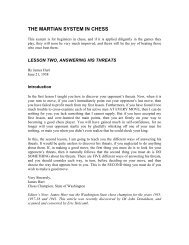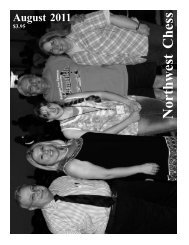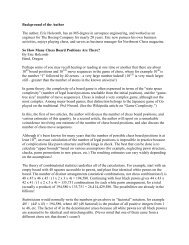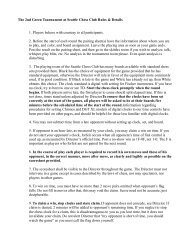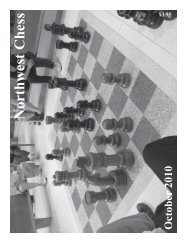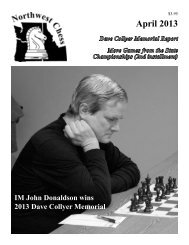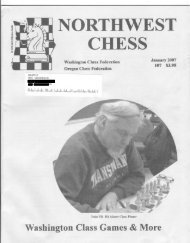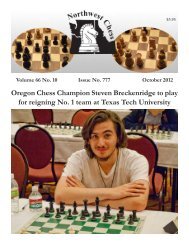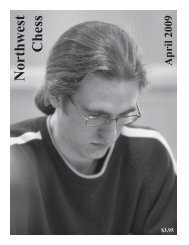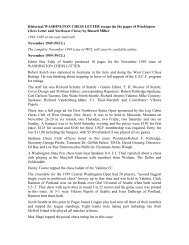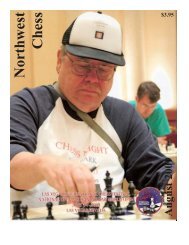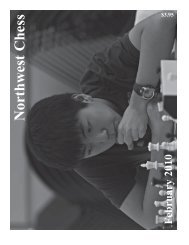January, 2012 - Idaho Chess Association
January, 2012 - Idaho Chess Association
January, 2012 - Idaho Chess Association
You also want an ePaper? Increase the reach of your titles
YUMPU automatically turns print PDFs into web optimized ePapers that Google loves.
28.¢g2 is much stronger.<br />
28...¥e3+ 29.¢g2 ¤f6 30.£f5<br />
XABCDEFGHY<br />
8r+-+-+-+(<br />
7zpp+-mk-+-'<br />
6-+pzp-sn-+&<br />
5+-+-+Q+-%<br />
4-+-+P+P+$<br />
3+-zPPvl-+P#<br />
2PzP-+-+K+"<br />
1+-+-+-+-!<br />
xabcdefghy<br />
30...¦e8<br />
After 30...¦h8! 31.d4 (Not 31.e5<br />
¤d5, as the Knight will land on f4, leaving<br />
Black close to equality.) 31...¤d7 32.<br />
e5 dxe5 33.dxe5 ¦f8 34.£d3 ¥f4 35.<br />
£d6+ ¢d8 36.£b4 b6, White has some<br />
ways to go before winning. Bad for<br />
Black are 30...¦f8? 31.e5 ¤d7 32.<br />
£h7+ ¢d8 [32...¢e6 33.£g6+ ¢e7<br />
(33...¢xe5 34.£e4+) 34.exd6+] and<br />
30...¤d7? 31.£h7+.<br />
31.h4 ¤d7 32.g5 ¥c1 33.£f2?<br />
I expected 33.£h7+ ¢d8 34.g6<br />
¥xb2 35.h5 ¥xc3 36.h6, when his<br />
pawns are too fast. White can probably<br />
force the sacrifice of a piece for only one<br />
pawn. Also good is 33.h5.<br />
33...¦f8 34.£xa7 ¥xb2 35.£xb7<br />
¥xc3 36.£xc6 ¥e1!<br />
37.e5!!<br />
XABCDEFGHY<br />
8-+-+-tr-+(<br />
7+-+nmk-+-'<br />
6-+Qzp-+-+&<br />
5+-+-+-zP-%<br />
4-+-+P+-zP$<br />
3+-+P+-+-#<br />
2P+-+-+K+"<br />
1+-+-vl-+-!<br />
xabcdefghy<br />
I totally missed this! A great find by<br />
the GM. If he did anything else, I might<br />
be able to recover my position, e.g., 37.d4<br />
¥xh4 38.e5! dxe5 39.dxe5, when I must<br />
determine the most effective way to sacrifice<br />
my Bishop, either 39...¥xg5<br />
40.£d6+ ¢e8 41.g6 or 39...¤xe5<br />
40.£e4.<br />
37...dxe5<br />
37...¤xe5 may have been better, but<br />
his Queen is so well placed on e4 after<br />
38.£e4 ¥d2 39.d4 ¦f4 40.£h7+ ¦f7<br />
41.£c2 ¤f3 42.¢g3 ¦f4 43.g6 that it<br />
seems he's about finished me.<br />
38.£e4 ¥c3 39.h5 ¦f4 40.£h7+<br />
¦f7 41.£g8 ¦f8 42.£g6 ¤c5 43.<br />
h6<br />
I expected 43.£c6 ¥d4 44.g6 ¤e6<br />
45.h6 ¤f4+, hoping for a perpetual, as<br />
46.¢g3 ¤e2+ 47.¢g4 ¦f4+ 48.¢h5<br />
¦f5+ 49.¢g4 ¦f4+ 50.¢g5 ¥e3 51.<br />
£c7+ doesn't look too appealing for<br />
White.<br />
43...¤e6 44.£h7+ ¦f7 45.£g8<br />
¦f8??<br />
I moved way too fast, thinking he<br />
would have to play 46.£h7+ and then go<br />
to e4. I should have played 45...¦f5<br />
46.g6 ¤f4+ 47.¢g3 ¦g5+ 48.¢f3<br />
¤xg6 49.h7 e4+ 50.¢xe4 ¦e5+ 51.¢f3<br />
¦e6 and I might have held the draw,<br />
e.g., 52.a4 ¤e5+ 53.¢g2 ¤f7.<br />
46.h7 e4 47.dxe4 ¥g7 48.a4 1-0<br />
At the halfway point GMs Akobian<br />
and Khachiyan led with 3.5/4. I, having<br />
beaten two FMs and a WFM, was in a<br />
tie for third-sixth on three points with GM<br />
Friedel, IM Larry Remingler, and FM<br />
Eduardo Ortiz.<br />
C84 Ruy Lopez Anderssen<br />
NM Steven Breckenridge (2290)<br />
FM Harutyun Akopyan (2351)<br />
Los Angeles, American Open (2) 2011<br />
Annotations by NM Steven Breckenridge<br />
1.e4 e5 2.¤f3 ¤c6 3.¥b5 a6<br />
4.¥a4 ¤f6 5.O-O ¥e7 6.d3<br />
I used to play a lot of mainline Ruy<br />
Lopez with h2-h3 to avoid the Marshall<br />
Attack. Occasionally, I allowed the<br />
Marshall, but played 9.d4. And if opponents<br />
chose the mainline Closed Ruy with<br />
d7-d6 immediately, I would continue with<br />
d3 to avoid theory, i.e., 6.¦e1 b5 7.¥b3<br />
O-O 8.h3 (8.c3 d5 9.d4) 8...d6 9.c3 ¤a5<br />
10.¥c2 c5 11.d3.<br />
6...b5 7.¥b3 d6 8.a4 b4<br />
I had just played a game against<br />
Brian Esler in the Portland Fall open that<br />
went 8...¥b7 9.¤c3 b4 10.¤d5 ¤xd5<br />
11.¥xd5 O-O, where I blundered with<br />
12.a5? and he didn’t take the pawn immediately!<br />
The game continued 12...<br />
¦b8 (12...¤xa5 13.¦xa5 c6 14.¥xf7+<br />
¦xf7 15.¦a1) 13.¥e3 ¤xa5 (but now<br />
I don’t have to take on a5) 14.¥xb7<br />
¤xb7 15.¦xa6.<br />
XABCDEFGHY<br />
8-tr-wq-trk+(<br />
7+nzp-vlpzpp'<br />
6R+-zp-+-+&<br />
5+-+-zp-+-%<br />
4-zp-+P+-+$<br />
3+-+PvLN+-#<br />
2-zPP+-zPPzP"<br />
1+-+Q+RmK-!<br />
xabcdefghy<br />
It was a pretty exciting game, which<br />
ended in a draw, though it got extremely<br />
tactical, with many crazy lines.<br />
9.a5<br />
This is still theory.<br />
9...¤b8!?<br />
The line goes 9...O-O 10.¤bd2 ¥e6<br />
11.¥c4 (11. ¤c4 ¤d7 12.¥e3).<br />
10.d4?!<br />
An alternative was 10.¥e3 c5 11.<br />
¤bd2 ¤c6 12.¤c4 O-O 13.£b1 (or<br />
perhaps 13.¤b6 ¦b8 14.¤xc8 ¦xc8<br />
15.¥c4 ¦a8, giving up a pawn for the<br />
Bishop pair.<br />
10...exd4<br />
11.c3?!<br />
XABCDEFGHY<br />
8rsnlwqk+-tr(<br />
7+-zp-vlpzpp'<br />
6p+-zp-sn-+&<br />
5zP-+-+-+-%<br />
4-zp-zpP+-+$<br />
3+L+-+N+-#<br />
2-zPP+-zPPzP"<br />
1tRNvLQ+RmK-!<br />
xabcdefghy<br />
I wanted to make chess a little interesting.<br />
My original idea was 11.¤xd4<br />
c5 12.¥a4+ ¥d7 13.¤f5 O-O 14.¥xd7<br />
(14.¥f4 ¥xf5 15.exf5) 14...£xd7 15.<br />
Visit Northwest<br />
<strong>Chess</strong> on Facebook!<br />
¥f4 ¦e8 16.¤xe7+ £xe7 17.¦e1. I<br />
also considered 11.£xd4 c5 12.£d3 (12.<br />
£e3 ¤c6 13.¦d1 £c7 14.¤bd2 ¤xa5<br />
Northwest <strong>Chess</strong> <strong>January</strong> <strong>2012</strong> 17



